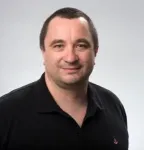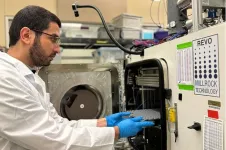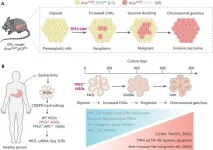(Press-News.org) MAY 7, 2024, NEW YORK – Using artificial intelligence, Ludwig Cancer Research scientists have developed a powerful predictive model for identifying the most potent cancer killing immune cells for use in cancer immunotherapies.
Combined with additional algorithms, the predictive model, described in the current issue of the journal Nature Biotechnology, can be applied to personalized cancer treatments that tailor therapy to the unique cellular makeup of each patient's tumors.
“The implementation of artificial intelligence in cellular therapy is new and may be a game-changer, offering new clinical options to patients,” said Ludwig Lausanne’s Alexandre Harari, who led the study with graduate student Rémy Pétremand.
Cellular immunotherapy involves extracting immune cells from a patient's tumor, optionally engineering them to enhance their natural abilities to combat cancer and reintroducing them to the body after they’ve been expanded in culture. T cells are one of the two main types of white blood cells, or lymphocytes, that circulate in the blood and patrol for virally infected or cancerous cells.
T cells that penetrate solid tumors are known as tumor-infiltrating lymphocytes, or TILs. However, not all TILs are effective at recognizing and attacking tumor cells. “Only a fraction is in fact tumor reactive—the majority are bystanders,” Harari explained. “The challenge we set for ourselves was to identify the few TILs that are equipped with T cell receptors able to recognize antigens on the tumor.”
To do this, Harari and his team developed a new AI-driven predictive model, called TRTpred, that can rank T cell receptors (TCRs) based on their tumor reactivity. To develop TRTpred, they used 235 TCRs gathered from patients with metastatic melanoma, already classified as either tumor-reactive or non-reactive. The team loaded the global gene-expression—or transcriptomic—profiles of the T cells carrying each TCR into a machine learning model to identify patterns that differentiate tumor-reactive T cells from inactive counterparts.
“TRTpred can learn from one T cell population and create a rule which can then be applied to a new population,” Harari explained. “So, when faced with a new TCR, the model can read its transcriptomic profile and predict whether it is tumor reactive or not.”
The TRTpred model analyzed TILs from 42 patients with melanoma and gastrointestinal, lung and breast cancer and identified tumor-reactive TCRs with about 90 percent accuracy. The researchers further refined their TIL selection process by applying a secondary algorithmic filter to screen for only those tumor-reactive T-cells with “high avidity”—that is, those that bind strongly to tumor antigens.
“TRTpred is exclusively a predictor of whether a TCR is tumor reactive or not,” Harari explained. “But some tumor-reactive TCRs bind very strongly to tumor cells and are therefore very effective, while others only do so in a lazy way. Distinguishing the strong binders from the weak ones translates into efficacy.”
The researchers demonstrated that T cells flagged by TRTpred and the secondary algorithm as both tumor-reactive and having high avidity were more often found embedded within tumors rather than in the adjacent supportive tissue, known as stroma. This finding aligns with other research showing that effective T cells typically penetrate deep into tumor islets.
The team then introduced a third filter to maximize recognition of diverse tumor antigens. “What we want is to maximize the chances the TILs will target as many different antigens as possible,” Harari said.
This final filter organizes TCRs into groups based on similar physical and chemical characteristics. The researchers hypothesized that TCRs in each cluster recognize the same antigen. “So, we pick within each cluster one TCR to amplify, so that we maximize the chances of distinct antigen targets,” said Vincent Zoete, a computational scientist at Ludwig Lausanne who developed the TCR avidity and the TCR clustering algorithms.
The researchers call the combination of TRTpred and the algorithmic filters MixTRTpred.
To validate their approach, Harari's team cultivated human tumors in mice, extracted TCRs from their TILs and used the MixTRTpred system to identify T cells that were tumor-reactive, had high avidity and targeted multiple tumor antigens. They then engineered T cells from the mice to express those TCRs and showed that these cells could eliminate tumors when transferred into the mice.
“This method promises to overcome some of the shortcomings of current TIL based therapy, especially for patients dealing with tumors not responding to such therapies today,” said Ludwig Lausanne Director George Coukos, a co-author of the study who is planning to launch a Phase I clinical trial that will test the technology in patients.
“Our joint efforts will bring forth a completely new type of T cell therapy.”
This study was supported by Ludwig Cancer Research, the Swiss National Science Foundation, the Cancera Foundation, the Mats Paulssons Foundation and the Biltema Foundation.
Alexandre Harari is a PI in the Hi-TIDe team at Ludwig Lausanne and an associate professor at the University of Lausanne.
# # #
About Ludwig Cancer Research
Ludwig Cancer Research is an international collaborative network of acclaimed scientists that has pioneered cancer research and landmark discovery for more than 50 years. Ludwig combines basic science with the translation and clinical evaluation of its discoveries to accelerate the development of new cancer diagnostics, therapies and prevention strategies. Since 1971, Ludwig has invested nearly $3 billion in life-changing science through the not-for-profit Ludwig Institute for Cancer Research and the six U.S.-based Ludwig Centers. To learn more, visit www.ludwigcancerresearch.org.
For additional information please contact communications@ludwigcancerresearch.org.
END
PROVIDENCE, R.I. [Brown University] — A new analysis revealed the frequency of potentially lethal substances, such as fentanyl and xylazine, in counterfeit pills that had been circulating in Rhode Island’s illicit drug supply.
Study author Dr. Rachel Wightman, an associate professor of epidemiology and emergency medicine at Brown University, said the analysis provides important information about the composition of counterfeit pills, which are designed to replicate legitimate pharmaceutical pills but often lead to adverse health effects.
“The level of detail found in our analysis can help inform treatment conversations and improve patient care,” ...
INDIANAPOLIS – Researchers have discovered a protein marker to help identify cells able to repopulate in patients with damaged blood vessels. Their findings, recently published in Circulation, could lead to new therapies for people with endothelial dysfunction, a type of disorder that contributes to coronary artery disease that may occlude with plaque and lack ability to carry sufficient blood into the heart tissue causing a heart attack.
“This study is the first to establish that a single, prospective marker identifies vascular clonal repopulating endothelial cells ...
As part of the University of Colorado Department of Medicine’s annual Research Day, held on April 23, faculty member Christine Swanson, MD, MCR, described her National Institutes of Health-funded clinical research on whether adequate sleep can help prevent osteoporosis.
“Osteoporosis can occur for many reasons such as hormonal changes, aging, and lifestyle factors,” said Swanson, an associate professor in the Division of Endocrinology, Metabolism, and Diabetes. “But some patients I ...
WEST LAFAYETTE, Ind. — LyoWave Inc., a high-tech startup, is commercializing innovative microwave heating technologies developed at Purdue University that improve upon traditional lyophilization — or the process of freeze-drying perishable products — by increasing speed, cost-effectiveness and product throughput.
CEO and co-founder Drew Strongrich said LyoWave’s microwave energy innovations open new possibilities for a variety of products.
“Our technology overcomes the historic issues associated with microwave systems such as nonuniform heating, poor ...
Cheers erupted from a crowd gathered at the University of Colorado Anschutz Medical Campus on April 19 as leaders at the CU School of Medicine and the United States Air Force Academy (USAFA) signed an educational partnership agreement, a historic moment that will open a breadth of opportunities for both institutions.
“This is a very happy occasion for us and formalizes something that we always seek to have, which is a mutually beneficial partnership with colleagues in the state,” said John J. Reilly Jr., MD, dean ...
“The independent research groups, led by Prof. Scott W. Lowe and Christina Curtis,respectively, have uncovered a similar definitive pathway in the progression of gastric cancer (GC) initiated with loss of the TP53 gene, representing a milstone in understanding the early stages of this deadly disease”. Dr. Zhaocai Zhou, head of a GC laboratory from Fudan University, stated.“Their study offers detailed insights into how genetic changes drive the transformation from preneoplastic conditions to full-blown cancer. Their findings revealed that loss of TP53 is not merely a common genetic anomaly but a pivotal event that propels ...
A recent review article provides critical insights into the management of acute agitation in reproductive-age females and during pregnancy within the emergency departments (EDs). The study emphasizes the importance of considering the safety of psychotropic medications in this demographic population, given the potential risks to both the patient and the fetus.
Agitation in the emergency department is not uncommon and can stem from various causes, including psychiatric disorders, substance abuse, and other medical ...
COLUMBIA, Mo. (May 7, 2024) ― More Americans suffer from chronic pain than diabetes, heart disease, and cancer combined. Yet, a shortage of pain medicine specialists persists, causing many pain sufferers to seek care in primary care settings.
Researchers from the University of Missouri School of Medicine have found that an innovative tele-mentoring program can help address reliance on opioids in the management of pain, with potential benefits for patients, families and communities.
Project Extension for Community Healthcare Outcomes (ECHO) is an innovative educational and mentoring model where ...
A study has outlined the critical needs and essential technologies for a Low Earth Orbit (LEO) constellation to augment satellite navigation systems, significantly improving the Positioning, Navigation and Timing (PNT) services. This research specifically targets the diverse demands of different users for LEO augmented GNSS, the possible contribution of LEOs to PNT performances, and the key technologies referring to the LEO-based navigation augmentation system.
The Global Navigation Satellite Systems (GNSS), including the BeiDou Navigation Satellite System (BDS), are the most widely used in providing PNT services. However, GNSS signals from geostationary orbit (GEO), inclined ...
Earthquakes are the most dramatic and noteworthy results of tectonic plate movement. They are often destructive and deadly, or at the very least physically felt — they’re literally groundbreaking geological events. However not all tectonic movement results in effects that humans can perceive.
Slow slip events occur when pent up tectonic forces are released over the course of a few days or months, like an earthquake unfolding in slow motion. The more gradual movement means people won’t feel the earth shaking beneath their feet and buildings won’t collapse. But the lack of destruction does not make slow slip events less scientifically ...






